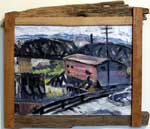VAM galleries including this work:
Behringer-Crawford Museum | Kentucky Past and Present || VAM Home
Harlan Hubbard (Kentucky, 1900-1988)
RAILROAD CROSSING IN NEWPORT, 1940
Oil on tin; 21" X 25"
Donated by Harlan Hubbard, 1986
From the Collection of the Behringer-Crawford Museum
Railroad Crossing in Newport is done in Harlan Hubbard’s distinct style of painting, which typically appears quickly rendered and simple in style. The painting’s subdued palette suggests that this work was painted as the sun was going down and everything was being cast into shadow.
About the Artist
Harlan Hubbard was born in Bellevue, in Northern Kentucky, on January 4, 1900. At the age of 15, he and his widowed mother moved to New York City to join his two older brothers, who were already living there. There Hubbard recognized his desire to become a painter and enrolled in the National Academy of Design Art School. In 1919, he returned to Northern Kentucky with his mother and attended the Cincinnati Art Academy.
Hubbard married Anna Eikenhout in 1943. The couple shared a dream of living on the Ohio River, and in 1944, Hubbard began building a boat from used lumber. The couple set sail in 1946, drifting down the Ohio and Mississippi rivers until they reached New Orleans and the bayous of Louisiana in 1951. After drifting all winter long, the Hubbards would settle ashore each summer and raise the crops that were to sustain them through their months of travel. In 1952, they sold their boat and bought a used car, then traveled through the western United States.
In 1952, the Hubbards returned to Payne Hollow in Trimble County, Kentucky, where they had spent the first summer of their journey. They purchased several acres of land along the Ohio River and built a two-room cabin and a studio for Harlan. The home was isolated—to reach it, the Hubbards and their visitors could either hike a one-mile trail from the road or row a boat across the river from Hanover, Indiana. The Hubbards lived without the modern conveniences of electricity and running water. They used a fireplace for heat, a woodstove for cooking, and a cistern for water. They kept goats for fresh milk and fished in the river. For things they couldn’t obtain from nature, they sold or bartered Harlan’s paintings.
The Hubbards chose to live on their own and were successful at it. They spent time each day doing things they enjoyed, both together and alone. Both were musicians—Anna played piano and Harlan violin—and they would play duets. They also read books aloud to each other every night.
Harlan created woodcut prints and paintings in oils, acrylics, and watercolors. Scenes he had seen along the rivers were often his subjects. Each year he made woodcut prints to send as the couple’s Christmas card.
He was also an author. Several of his books were published during his lifetime and still others after his death. The first, Shantytown, was published in 1953 and told of his and Anna’s trip down the Ohio and Mississippi. Numerous books have been written about Hubbard and his work, including Harlan Hubbard: Life and Work by Wendell Berry and The Woodcuts of Harlan Hubbard by Claude W. Caddell.
Though Hubbard rarely promoted his own artwork, he did hold a few exhibits and show his paintings in some galleries. He preferred, however, to sell his work to friends or to barter it for items he and his wife needed. He did accept commissions to paint large pieces and murals for businesses along the Ohio River.
After 43 years of marriage, Anna Eikenhout Hubbard died in 1986. Harlan died two years later. Their ashes are buried on a hillside near their cabin in Payne Hollow, marked only by a simple piece of rock.
![]() Video 1: Footage
of Harlan Hubbard painting from the KET series Kentucky Life.
Video 1: Footage
of Harlan Hubbard painting from the KET series Kentucky Life.
Video 2: Harlan Hubbard from the KET series Kentucky Life.
Classroom Ideas
Discussion: Why do you think Hubbard might have painted on tin? Do you think the tin support had an effect on the appearance of the painting or on the nature of the paint? In what style would you say this painting has been executed? What do you think of the Hubbards’ chosen way of life? Would you like to live that way? What things would you do each day to enjoy life? What work would you need to do in order to take care of yourself?
Activity: Using oil or acrylics, try painting on a variety of metals. If nothing else is available, you can try foil or an old tin can. Is painting on metal different from painting on paper or canvas? How?
Links
Artwork, exhibition listings, and photos of Harlan and Anna Hubbard can be found at Bill Caddell’s Harlan Hubbard Artwork site.
[dcwi.com/~hubbard/]
The Kentuckiana Digital Library has a series of interviews with Harlan Hubbard conducted in 1987.
[kdl.kyvl.org/cgi/t/text/text-idx?c=oralhist&tpl=kukohhh.tpl]
The Frankfort Community Library web
site has information about the Anna and Harlan Hubbard School of Living.
[www.accs.net/fcpl/harlan.htm]
Read about the Kentucky Life segment on the Hubbards at the KET web site. [www.ket.org/kentuckylife/800s/kylife814.html]
Learn more
about Harlan Hubbard the writer at the bookclub@ket web
site [www.ket.org/bookclub/books/2002_jun/]








